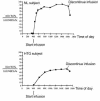Effects of a low-fat, high-carbohydrate diet on VLDL-triglyceride assembly, production, and clearance
- PMID: 10525047
- PMCID: PMC408572
- DOI: 10.1172/JCI6572
Effects of a low-fat, high-carbohydrate diet on VLDL-triglyceride assembly, production, and clearance
Abstract
Low-fat, high-carbohydrate (LF/HC) diets commonly elevate plasma triglyceride (TG) concentrations, but the kinetic mechanisms responsible for this effect remain uncertain. Subjects with low TG (normolipidemic [NL]) and those with moderately elevated TG (hypertriglyceridemic [HTG]) were studied on both a control and an LF/HC diet. We measured VLDL particle and TG transport rates, plasma nonesterified fatty acid (NEFA) flux, and sources of fatty acids used for the assembly of VLDL-TG. The LF/HC diet resulted in a 60% elevation in TG, a 37% reduction in VLDL-TG clearance, and an 18% reduction in whole-body fat oxidation, but no significant change in VLDL-apo B or VLDL-TG secretion rates. Significant elevations in fasting apo B-48 concentrations were observed on the LF/HC in HTG subjects. In both groups, fasting de novo lipogenesis was low regardless of diet. The NEFA pool contributed the great majority of fatty acids to VLDL-TG in NL subjects on both diets, whereas in HTG subjects, the contribution of NEFA was somewhat lower overall and was reduced further in individuals on the LF/HC diet. Between 13% and 29% of VLDL-TG fatty acids remained unaccounted for by the sum of de novo lipogenesis and plasma NEFA input in HTG subjects. We conclude that (a) whole-food LF/HC diets reduce VLDL-TG clearance and do not increase VLDL-TG secretion or de novo lipogenesis; (b) sources of fatty acids for assembly of VLDL-TG differ between HTG and NL subjects and are further affected by diet composition; (c) the presence of chylomicron remnants in the fasting state on LF/HC diets may contribute to elevated TG levels by competing for VLDL-TG lipolysis and by providing a source of fatty acids for hepatic VLDL-TG synthesis; and (d) the assembly, production, and clearance of elevated plasma VLDL-TG in response to LF/HC diets therefore differ from those for elevated TG on higher-fat diets.
Figures




References
-
- Connor WE, Connor SL. Should low-fat, high-carbohydrate diets be recommended for everyone? N Engl J Med. 1997;337:562–563. - PubMed
-
- Katan MB, Grundy SM, Willett WC. Beyond low-fat diets. N Engl J Med. 1997;337:563–566. - PubMed
-
- Ornish D. Low-fat diets [letter] N Engl J Med. 1998;338:128. - PubMed
-
- Rudel LL. Low-fat diets [letter] N Engl J Med. 1998;338:127. - PubMed
-
- Manning, A. Study: lowfat diets can go too far. USA Today. November 12, 1997. p. 1D.
Publication types
MeSH terms
Substances
Grants and funding
LinkOut - more resources
Full Text Sources
Other Literature Sources
Medical
Miscellaneous

